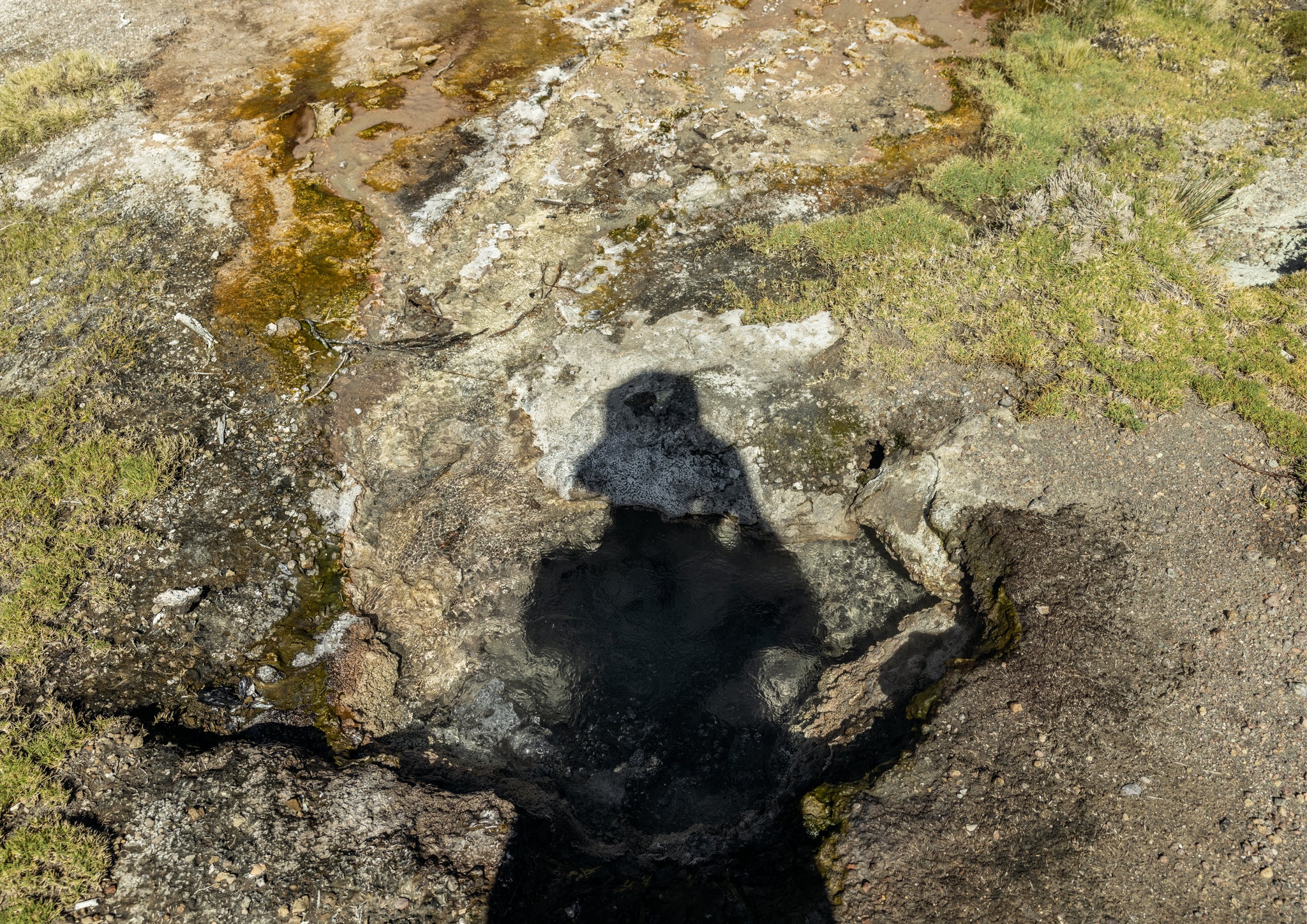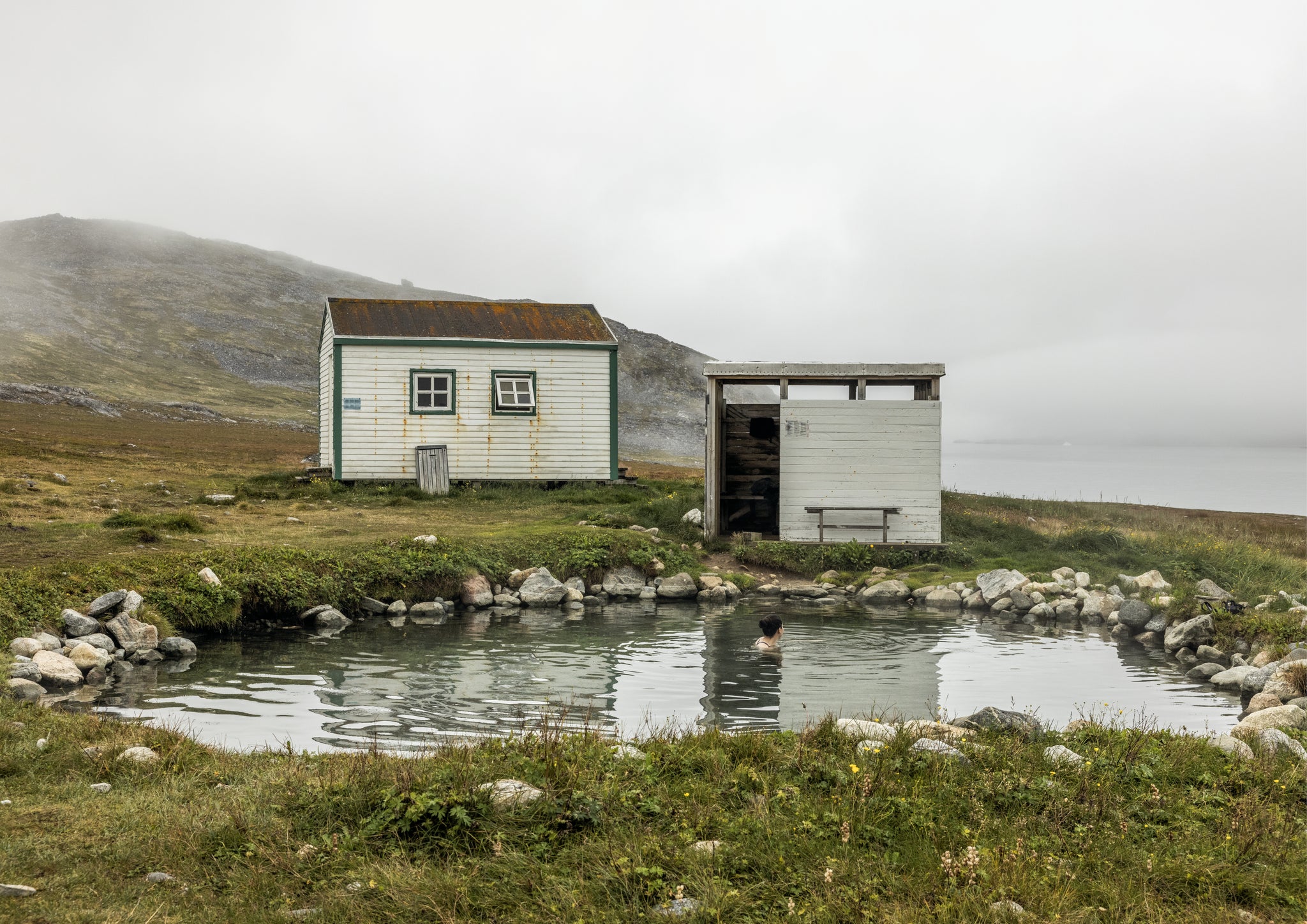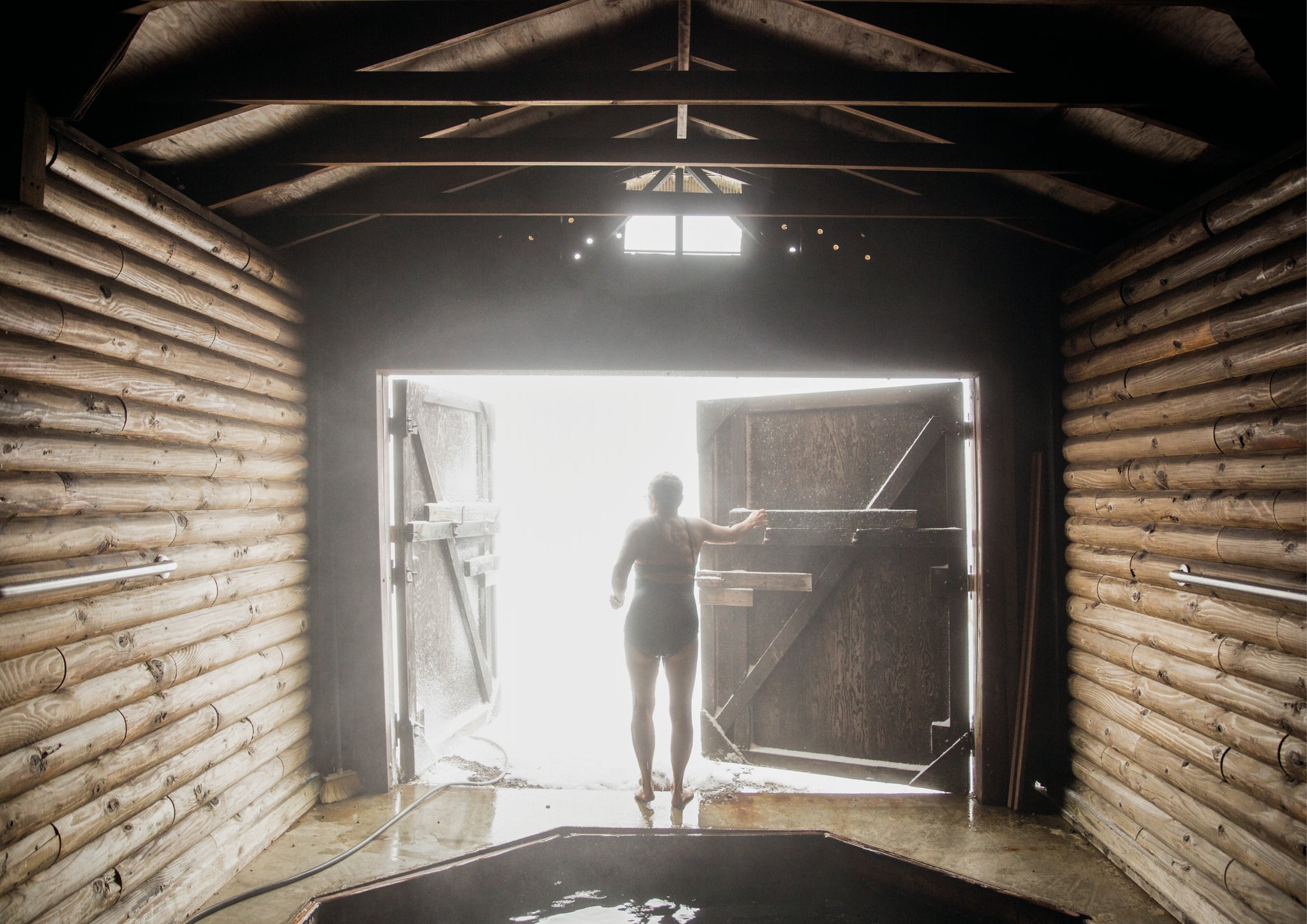 When Greta Rybus's Hot Springs landed on my desk, I first noticed its endpapers: rows of thumbnails featuring earthen locales with unique histories, candid portraits of people wringing out their hair or learning to swim. I found it beautiful and intriguing - a perfect visual primer for readers to experience "how the world soaks, swims, and slows down."
When Greta Rybus's Hot Springs landed on my desk, I first noticed its endpapers: rows of thumbnails featuring earthen locales with unique histories, candid portraits of people wringing out their hair or learning to swim. I found it beautiful and intriguing - a perfect visual primer for readers to experience "how the world soaks, swims, and slows down."
As a photojournalist, Greta is widely drawn to stories demonstrating "reciprocal relationships between people and nature." Currently based in Maine, she often captures farmers, fishermen, and others who stir that curiosity. Yet, in many ways, Hot Springs is a culmination of her life's work. From growing up and living in Idaho and Montana to a brief stint in Japan as a teenager, Greta's experiences with hot springs are wide-ranging, each offering their own form of refuge.
"There's another element [about the book] that I haven't talked about a ton," she notes. "A lot of people see their relationship with nature as one that requires quite a bit of work or effort - if your hobby is climbing a mountain, managing a garden, or fishing for food, there's often still quite a bit of energy involved with maintaining that experience in nature. What I felt curious about was that most people's experience with the hot spring is pretty restorative. You just go to the water and sit in it. It's a way of experiencing nature that's about receiving this bounty."
 Greta travelled to over two dozen locations worldwide to capture the beauty and caretaking of these special places. She also frequently turned to locals to help her get a lay of the land. In "The Great Basin's Wild Hot Springs," she mentions coming across a pamphlet that suggests taking "a 'wonder-wander,' an excursion to just see what you see, go where you want to go." In "Himachal Pradesh's Hot Water Temples," she writes about travelling to sites with spiritual undercurrents: "We bowed and touched the floor. … After that, he gave me an intention for this very book: 'We pray to Guru Vashisht so that well-being passes through you to the world."
Greta travelled to over two dozen locations worldwide to capture the beauty and caretaking of these special places. She also frequently turned to locals to help her get a lay of the land. In "The Great Basin's Wild Hot Springs," she mentions coming across a pamphlet that suggests taking "a 'wonder-wander,' an excursion to just see what you see, go where you want to go." In "Himachal Pradesh's Hot Water Temples," she writes about travelling to sites with spiritual undercurrents: "We bowed and touched the floor. … After that, he gave me an intention for this very book: 'We pray to Guru Vashisht so that well-being passes through you to the world."
Once home, Greta reflected on her conversations and encounters during quiet morning walks. "I started being able to think of sentences or structure, and then I would go back and write," she says. When I suggest that she'd unknowingly taken "wonder-wanders" to create Hot Springs, Greta laughs with glee. "I'm going to start saying that to myself: You have to get some writing done. Time for your wonder-wander."
While wonder is the baseline of Greta's work, it's only part of an increasingly nuanced conversation about caring for the world amid global strife. But for Greta, acknowledging nature's power isn't a bad place to start. "When I've been in hot springs, I definitely had moments where I just looked around and thought, Look at what nature can do. We get to experience [nature], and it really provides everything. It's remarkable. I'm just so in love with the fact that we get to have this planet in general. I felt like this [project] was a reminder of that - a very pure reminder.'
 After our call ends, Hot Springs remains open on my lap. I survey the landscape in front of me, and it's anything but natural: my phone, computer screen, two notebooks, a lukewarm cup of coffee, a stray bookmark, and a couple of cables. I peer out of my home office window and watch a steady rainfall. Like Greta, I'm nowhere near a hot spring, but I don't let that stop me. I decide to go for my own "wonder-wander," hoping each drop of rain reminds me of something true.
After our call ends, Hot Springs remains open on my lap. I survey the landscape in front of me, and it's anything but natural: my phone, computer screen, two notebooks, a lukewarm cup of coffee, a stray bookmark, and a couple of cables. I peer out of my home office window and watch a steady rainfall. Like Greta, I'm nowhere near a hot spring, but I don't let that stop me. I decide to go for my own "wonder-wander," hoping each drop of rain reminds me of something true.
How would you describe your relationship with wonder?
It's the basis of my photography in general. The world feels very dark in many ways, but I also feel pretty enamoured with it. If I can keep a relatively curious mind, there's a lot of wonder to behold. Photography is a very tangible way to experience that wonder.
How do you think creative documentation, like photography, helps us grow closer to the natural world?
When I think about how I feel when taking pictures, it's very present. I get to have a type of presence that's also creative. In nature, this collusion happens with what I'm photographing and the light. It's fun to let my brain have this moment of symbiosis with light. The weather is my ultimate boss, and how I photograph something depends on whether the sun shows up that day. That's a major deciding factor for how my photos will look and feel, and it's not always totally in my control. And so I like that aspect of my work. It's also challenging. Sometimes, I think something would be really well photographed during a cloudy day - and then it's a very sunny day or vice versa! But it just means my ultimate collaborators are elements of nature, and that's pretty fun.
 Something that struck me while reading Hot Springs was the impact of time and control. There's so much out of our control, especially in nature. Still, even with certain threats facing ejidos [a form of collective land ownership in Mexico] and certain sentō [Japanese bathhouses] closing, there seems to be this understanding that all will be well. Would you say you walked away from this project feeling optimistic?
Something that struck me while reading Hot Springs was the impact of time and control. There's so much out of our control, especially in nature. Still, even with certain threats facing ejidos [a form of collective land ownership in Mexico] and certain sentō [Japanese bathhouses] closing, there seems to be this understanding that all will be well. Would you say you walked away from this project feeling optimistic?
I think, in a lot of ways, we find ourselves at some crossroads as people. When I think about hot springs, there are some questions that we have. … what do we do with our natural resources? Because we have a larger population that is not well cared for in this country in terms of having access to healthcare and public places that don't require money to be exchanged - third spaces where people can gather and feel supported and welcomed. There's a major cultural precedent set of abusing land and resources. … That's one of the reasons why I didn't include a lot of wild hot springs [in the book] because we find ourselves figuring out what to do with these spaces - and a lot of times, they're being closed down.
That's not the focus of Hot Springs, but I did want to focus on places that provided some examples of where there are lessons to be learned - places where it's worth taking notes or sharing their stories. A lot of these hot springs were run collectively. [For example], in Mexico, the ejido system presents a way of sharing resources, work, and decision-making. The rest of the world might want to consider that as an option for solving problems of how to care for our resources together as a group. But I did feel a lot of optimism because I was shown kindness everywhere I went. Universally, I found helpers and caretakers, and their presence made me feel really hopeful. I also felt [that about] the people that I met in Hot Springs. They mingled together with strangers really beautifully, shared resources, and treated each other with kindness. I write about this in the India chapter, but a woman fainted from the heat, and before her body was able to hit anything, several women held her up and gave her cold water from their hands - and these were all women who were bathing. They're in the nude, holding other women up. It was intimate and sweet that their instinct was to be so helpful and giving, even in a vulnerable state. So, I think I feel a lot of optimism and hope, but I also feel that there is a lot of work to be done.
But I did feel a lot of optimism because I was shown kindness everywhere I went. Universally, I found helpers and caretakers, and their presence made me feel really hopeful. I also felt [that about] the people that I met in Hot Springs. They mingled together with strangers really beautifully, shared resources, and treated each other with kindness. I write about this in the India chapter, but a woman fainted from the heat, and before her body was able to hit anything, several women held her up and gave her cold water from their hands - and these were all women who were bathing. They're in the nude, holding other women up. It was intimate and sweet that their instinct was to be so helpful and giving, even in a vulnerable state. So, I think I feel a lot of optimism and hope, but I also feel that there is a lot of work to be done.
There is a sense of both urgency and slowness in Hot Springs: urgency to reform systems of how we think about nature, land, and each other, but also really grounding, slow moments. I wonder how this experience changed your relationship with time. In "Budapest Spas," a patron said, "When I go to the baths, I am time travelling," which I thought was really poignant.
I feel like there are two answers to this question. One is that, as a photographer, many of my assignments are very brief. I often have to work very quickly in the spaces I'm documenting. This book often felt that way. It wasn't like I could stay at each place for weeks and weeks. I was often there as long as I could afford to give myself time to be there. I kind of partitioned my brain in some ways: I would say, Okay, Greta, you're photographing now. Your camera is right here. Sometimes, I would be in the water with people, and if something happened or the light changed, I would pick up my camera and photograph it. But at almost every place, I also tried to give myself the ability to clock out and just be in the water and think about what it felt like in my body, reflect on the temperature, and give myself the experience of being slow.

In Greenland, I also remember being with three women lying on this little hillside above the hot spring, bundled up, drinking tea. I was just lying there thinking, I'm not being very productive. I should probably go back to the hot springs and photograph it in this beautiful light. But I think the time spent lying in the sun with these women is the point. That's actually the whole point of doing this work. It's not always getting the photographs - it's also being in companionship with other people, [making] memories. You go across the world to be with people and to be in these places. Of course, the conversations that I have, the images that I make, that's the work that needs to get done - but then there are other times when it's just important to be someone in the sun with other people with no agenda or goal. No need to make something.
With time, I keep thinking about when I was in college, and we'd be stressed out about exams or a boy, and my friend would say, 'Think of this geologic time scale. These mountains will erode one day; who cares?!' So I do think that there's also this idea of time where I'm soaking in part of a water cycle and the geological cycle. It's the same feeling as looking at the stars. It's nice to have those moments in your life where you soak in a hot spring and think, This water went all the way down to an inner part of the earth and then came back up and brought all these minerals with it, and heat. Here I am, sitting on the uppermost part of the earth's crust, having this little relationship with the inside of the planet.

It's interesting to hear about how these locales brought people back to their bodies in different ways, like using the hot spring as a healing place. There was one sentiment from the Icelandic anthropologist Helga Ögmun-dardóttir, who remarked, "Your body is irrelevant. Your body is your shelter in this life," which led to you writing, "The hot spring is a place with a warm perspective of our bodies." There was also the mention of the Japanese term "skinship," which I really loved. All of that to say, what have you learned about being with your body through this project, whether in the company of others or alone?
There is something protective about hot springs. When you prepare yourself to go into a hot spring, it never feels the same way as being on display, as it might be to prepare yourself to go to the beach. I was trying to figure out why that was, and there's just a different spirit about it. I felt like a lot of the other people I met also felt the same way. There's a very cared-for feeling of being in a hot spring. I think that also is reflected in how our body feels, including how our body is perceived.
In Japan especially - and I also heard this from people in Iceland - there is something very healing about very casually being within proximity to other people's bodies, whether old or young or big or small or scarred. It's just a nice perspective to see the body as a neutral, natural thing. I think people who were raised with that - going to the local thermal bath their whole life—it's probably helpful to see how a body can change over the years. I've found it helpful and pretty liberating, actually.
Hot Springs: Photos and Stories of How the World Soaks, Swims, and Slows Down by Greta Rybus is available now.
Words by Rachel Schwartzmann.
Photography by Greta Rybus.
Add a comment